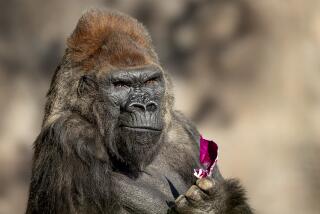Goolara, Zoo’s Rare Albino Koala, Dies of Cancer : Animals: Cuddly 7-year-old marsupial was a favorite with staff and visitors and even charmed Johnny Carson.
Goolara, the world’s only known albino koala, died at the San Diego Zoo after ailing with cancer for nearly two years, zoo officials said Sunday.
The 7-year-old popular koala, whose friendly disposition made him a hit with the zoo staff as well as visitors, was euthanized Saturday evening after severe internal hemorrhaging.
Snowy-white Goolara had pink paws, pink eyes and a pink mouth that--because of its up-curved shape--always made the koala look like he was smiling. During a 1987 television appearance on the “Tonight” show, Goolara even seemed to win the heart of host Johnny Carson.
Though Carson frequently had animals on his show, he didn’t usually have much to do with them when the cameras weren’t running. In Goolara’s case, however, Carson made an exception, San Diego Zoo spokeswoman Georganne Irvine said.
After the show, Carson came backstage and asked to hold the cuddly koala. With Goolara in his arms, Carson then requested that his picture be taken.
“Goolara was one of our favorite animals,” Irvine said. “And Johnny Carson was just enchanted with him.”
Among humans, albinism--or absence of pigmentation in the skin--is an extremely rare genetic condition that occurs in only one of 20,000 births. It is not necessary for either parent to be an albino if each carries the recessive gene for the trait. But very little is known about albino koalas, and San Diego Zoo keepers were shocked to find they had one.
When zookeeper Valerie Thompson first noticed the koala baby Sept. 21, 1985, all she could see was a little nose sticking out of the pouch of its mother, Matilda. For Thompson, it was quite a surprise: Usually, the nose poking out of a koala mother’s pouch is black. This time, it was pink.
“Every time I tried to get a better look, the nose disappeared into the safety of the pouch,” Thompson wrote in recalling the event. “I spent the subsequent several days trying to get a better look at the pink-nosed baby in an effort to dispel my fear that I had finally gone off the deep end.”
Thompson, however, finally got a good look at the baby and learned it was indeed an albino, an attribute that made the little koala sensitive to the sun and susceptible to sunburn.
Initially, because of the pronouncement of an inexperienced keeper, zoo officials thought the baby koala was female, Irvine said. And the baby was named Goolara, which means “moonlight” in the Aboriginal language. But the tiny koala also had several nicknames, including “Sweet Pea” and “Snowala.”
As soon as the keepers realized their error, however, those nicknames were replaced by others, including “Big Guy.”
Goolara’s father, Kalba, was also an albino koala. He died at the Lone Pine Koala Sanctuary in Brisbane, Australia, in 1977. Goolara’s mother, Matilda, died of cancer several months after giving birth. After her death, the baby koala became accustomed to being handled by people because he was frequently bottle-fed.
Zoo veterinarians first noticed a small, cancerous tumor in the palate of Goolara’s mouth in January, 1991. They operated and removed the tumor, and monitored their furry patient for several months.
But last spring, keepers noticed that Goolara was drooling and having trouble chewing his eucalyptus leaves. When the vets examined him again, they found another tumor, this one on the roof of his mouth. They operated and removed a portion of the new tumor June 3.
Last month, however, Goolara--who never fathered offspring--began to worsen. He started to lose weight and become weak. In recent days, Goolara had become so weak that he had trouble sitting on his usual perch.
On Saturday, the koala could sit only on the floor of his enclosure. He made sharp pleading-like noises that made his keepers think he was in pain. By the late afternoon, Goolara had become so weakened that he could not hold up his head.
Veterinarian Don Janssen put Goolara to sleep at 5 p.m. A necropsy showed that the koala also had bleeding of the large intestine.
Because Goolara was so rare, zoo officials say his body will probably be donated to a museum.
“I still remember the day I first saw him,” Irvine said. “There was this little white koala peering out of his mother’s pouch. At that moment, he won my heart. We have all been rooting for him.”
More to Read
Sign up for Essential California
The most important California stories and recommendations in your inbox every morning.
You may occasionally receive promotional content from the Los Angeles Times.










